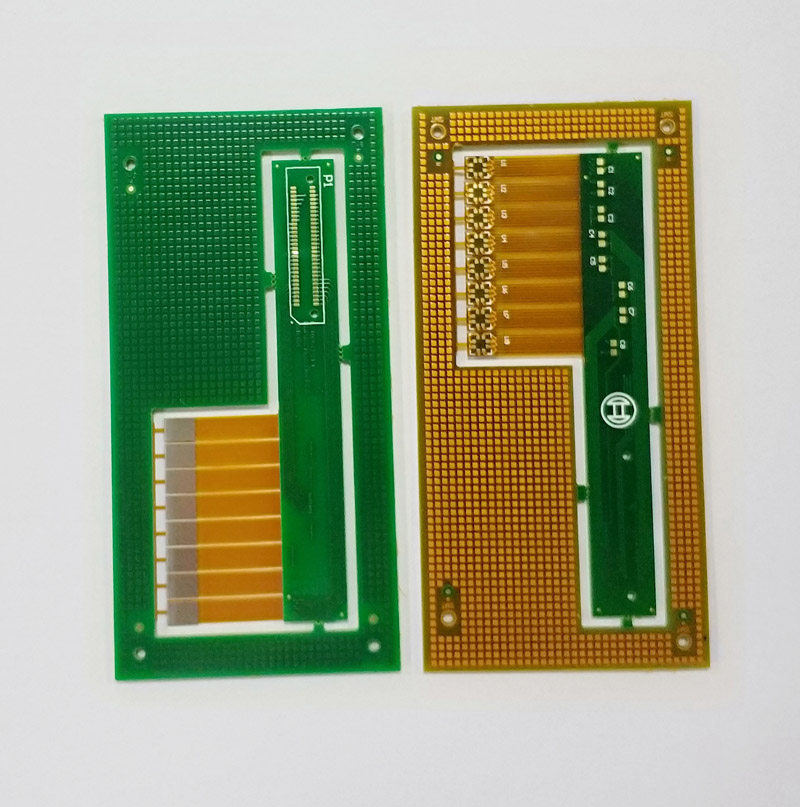One - layer FPC board
It has a layer of chemically etched conductive pattern, and the conductive pattern layer on the flexible insulating base material is calendered copper foil. Insulating substrates may be polyimide, polyethylene terephthalate, aromatic amide fibre ester and polyvinyl chloride. Single-layer FPC boards can be divided into the following four sub-categories:
1. Single-side connection of FPC boards without covering layer
The wire figure is on the insulating material, and the wire surface has no covering layer. The interconnection is realized by tin welding, fusion welding or pressure welding, which is commonly used in the early telephone sets.

2. The FPC board is covered with single-side connection
Compared with the previous class, there is only a covering layer on the wire surface. When covering, the pad should be exposed, simply not covered in the end area. It is one of the most widely used single-sided soft PCB, which is used in automobile instrument and electronic instrument.
3. The FPC board is connected on both sides without covering layer
The connecting plate interface can be connected on both the front and back of the wire, and a path hole is opened on the insulating substrate at the pad. The path hole can be made by punching, etching or other mechanical means at the desired position of the insulating substrate.
4. The FPC board has overlay double-sided connection
Unlike the previous class, the surface is covered with a covering layer that has access holes to allow both sides to be joined and still remain covered, made of two layers of insulating material and one layer of metal conductor.
Two. Double-sided FPC board
The double-sided FPC board has a conductive pattern etched on each side of the insulating base film, increasing the wiring density per unit area. Metallized holes connect the shapes on both sides of the insulating material to form conductive paths to meet the design and use of flexure. And the covering film can protect the single and double - sided wire and indicate the position of the element. According to the demand, the metallized hole and cover layer is optional, this type of FPC board is rarely used.
Multilayer FPC board
Multi-layer FPC board is made of 3 or more layers of single or double FPC board laminated together, through drilling hole, electroplating to form metallized hole, forming conductive path between different layers. In this way, there is no need to use complex welding process. Multilayer circuits have huge functional differences in higher reliability, better thermal conductivity and easier assembly performance.
The advantage is that the substrate film is light in weight and has excellent electrical properties such as low dielectric constant. Multilayer soft PCB made of polyimide film is about 1/3 lighter than rigid epoxy glass cloth multilayer PCB, but it loses the excellent flexibility of single-sided and double-sided soft PCB, which is not required for most such products. Multi-layer flexible circuit boards can be further divided into the following types:
1. Flexible insulating base material finished products
This class is manufactured on a flexible insulating base material and the finished product is specified to be flexable. This structure typically binds the two ends of many single - or double-sided microstrip flexible PCBS together, but the central portion is not bonded together, resulting in a high degree of flexibility. For a high degree of flexibility, a thin, suitable coating, such as polyimide, may be applied to the conductor layer instead of a thicker laminated overlay.
2. Finished products of soft insulation base material
This class is manufactured on a soft insulating base material and the end product is specified to be flexible. This type of multilayer flexible circuit board is made of a soft insulating material, such as polyimide film, laminated into a multilayer board that loses its inherent flexibility after lamination.
Contact: Ms.Huang
Phone: 15023181892(微信同號)
Tel: 0755-23289186
Email: [email protected]
Add: xingye road,14th,bao'an shenzhen city CHINA